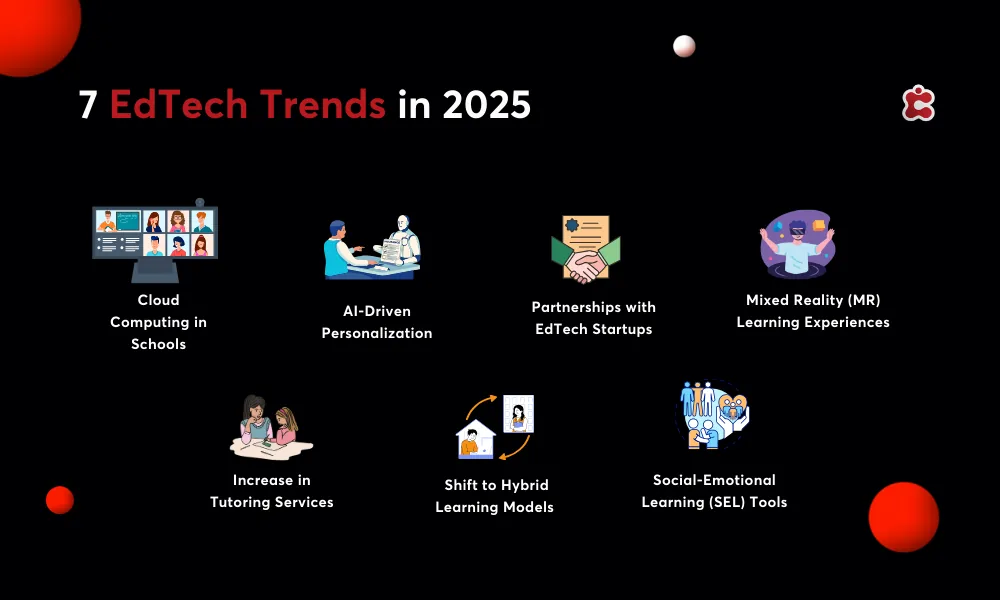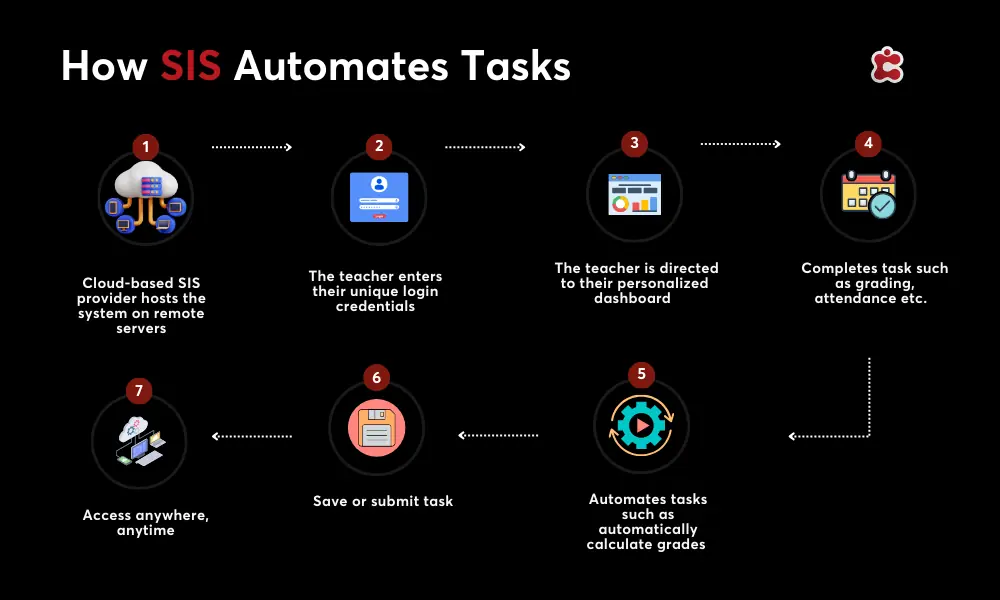2025 is just around the corner, and calling the changes in edtech “big” is an understatement. The digital education space is set to skyrocket, with a projected growth of $404 billion. For schools, this isn’t just about keeping up. It’s about embracing exciting shifts that can transform how students learn and how teachers and staff handle the everyday challenges of running a school.
We’re breaking down the top 10 education technology trends that every school needs to watch for in 2025. Think about it: cloud computing that lets everyone access school resources anywhere. AI that can personalize learning, mixed reality experiences that bring lessons to life. Micro-learning that fits right into the modern student’s busy schedule. These trends don’t just sound cool—they’re set to make a real impact on how schools engage students, protect data, and streamline tasks.

1. Expanding Cloud Computing in Schools
It’s no surprise that more and more schools are migrating their operations to the cloud. By 2025, we’ll likely see even more schools adopting cloud-based systems, driven by advancements in security, user-friendly interfaces, and tailored applications for education. As cloud technology evolves, schools will have access to more specialized tools that cater to everything from administrative workflows to interactive lesson plans. And with enhanced cybersecurity measures, schools can feel confident that sensitive data is protected. Whether it’s a teacher updating grades from home, a student checking assignments on the go, or an administrator managing enrollment data remotely, the cloud is making school management simpler and more efficient.
2. AI-Driven Personalization in Education
AI has impacted every aspect of our lives. But when it comes to education, it’s all about personalization. While many schools have already adapted AI-driven insights to support learning, 2025 promises even more powerful ways to tailor education to each student’s needs.
Here’s why AI-driven personalization is so important:
- Personalized Feedback: AI systems can analyze a student’s progress in real-time, offering constructive feedback right when it’s most impactful, helping students stay motivated and on track.
- Adaptive Learning Paths: By adapting lessons based on each student’s strengths, weaknesses, and learning style, AI can help students achieve mastery at their own pace.
- Data-Driven Insights: AI doesn’t just benefit students—teachers get access to valuable data about individual and group performance, helping them make informed decisions on where to focus.
3. Partnerships with EdTech Startups
The power of partnerships is transforming education, and edtech startups are at the forefront of this shift. Schools have traditionally relied on large, established companies for technology, but a growing trend of collaboration with edtech startups is introducing fresh, innovative solutions tailored to the needs of modern classrooms. By 2025, partnerships with startups will be a key strategy for schools looking to bring in cutting-edge tools that enhance learning and streamline operations.
Platforms like Classter offer schools specialized, flexible solutions that go beyond the typical one-size-fits-all approach. These startups bring agility and creative ideas, allowing schools to implement features such as customizable student information systems, automated administrative tasks, and enhanced communication tools.
4. The Rise of Mixed Reality (MR) Learning Experiences
We’ve all heard about Virtual Reality (VR) and Augmented Reality (AR), but Mixed Reality (MR) is the next big leap, combining both to create immersive, interactive experiences that are perfect for education. Unlike traditional learning tools, MR blends virtual and real-world elements, allowing students to interact with 3D models, simulations, and even holographic teachers within their physical classroom. By 2025, expect MR to redefine how students engage with complex subjects. As MR hardware becomes more affordable and software continues to improve, it will become more accessible for schools of all sizes.
- MR brings lessons to life, encouraging active learning and making abstract concepts tangible.
- Complex skills can be learned through realistic simulations, offering practice without real-world risks.
- From history to science, MR offers versatile applications across subjects.
5. Increase in Tutoring Services
Tutoring has always been a valuable support for students. And today, it’s more accessible and flexible than ever, thanks to edtech. In fact, a survey by the U.S. Department of Education revealed that over 80% of schools now offer some form of tutoring, ranging from after-school homework help to intensive, one-on-one sessions. But what’s exciting is how technology is reshaping tutoring to fit the needs of students and teachers alike. Digital tutoring solutions allow students to access help anytime, whether it’s a quick homework question or a deeper dive into a difficult topic. Many platforms also support video sessions, letting students connect with tutors from home. By 2025, we can expect even more schools to integrate online and hybrid tutoring solutions. This is mainly due to edtech services becoming more affordable and easy to implement. With the right tools, tutoring becomes a core part of the modern learning experience, helping students stay confident and engaged.
6. The Shift to Hybrid Learning Models
Since COVID-19 turned our world upside down, hybrid learning has emerged as a powerful solution for schools looking to adapt to the changing needs of students. But it is no longer just a temporary fix. Hybrid learning has become a viable option for schools aiming to enhance educational experiences. Looking ahead to 2025, we can expect hybrid learning to become more refined and widely accepted as a standard approach. Schools will invest in robust technology and training to ensure teachers can seamlessly switch between online and in-person formats. With ongoing advancements, hybrid classrooms will likely feature enhanced tools for collaboration and interaction, making learning not only more accessible but also more engaging. Embracing this shift means fostering an environment where every student can thrive, regardless of their learning style. The future of education is bright, and it’s all about flexibility and connection!

7. Focus on Social-Emotional Learning (SEL) Tools
As schools recognize the importance of nurturing the whole student, social-emotional learning (SEL) tools are taking center stage. SEL gives students the skills to manage their emotions, build healthy relationships, and navigate the ups and downs of daily life. With mental health and well-being now a top priority, digital SEL tools are helping educators address students’ emotional and social development.
These tools allow schools to track and support students’ mental well-being through features like mood check-ins, and personalized coping strategies. In addition, it’s analytics that gives teachers insight into how students are feeling over time. Imagine a platform that prompts students to reflect on their emotions at the start of the day, providing teachers with valuable context to support them. Such proactive approaches can make a world of difference. This is especially true in a time when mental health challenges among students are on the rise.
Classter: Keeping Schools Ready for 2025
As we look toward the future of education, staying ahead with the right tools and technology is essential. Classter, an innovator in the edtech space, offers a comprehensive school management solution that prepares schools for 2025. From handling complex student data to fostering personalized learning journeys, Classter empowers institutions to adapt seamlessly to a more digital, data-driven world.
With Classter, schools can streamline every aspect of administration—from admissions and attendance tracking to course scheduling and grading. By integrating AI and analytics, Classter helps educators make better, faster decisions that respond directly to student needs, creating more tailored learning experiences. Moreover, Classter’s platform supports social-emotional learning by allowing teachers and administrators to monitor and address students’ mental well-being, making it an all-encompassing tool for student success.
Ready to prepare your school for 2025 and beyond? Discover how Classter can bring your vision of an innovative, efficient, and student-centered learning environment to life. Start your journey with Classter today!
FAQ’s
In 2025, schools can expect trends like cloud computing, AI-driven personalized learning, mixed reality experiences, social-emotional learning (SEL) tools, and hybrid learning models to transform education. These trends aim to enhance student engagement, streamline school operations, and create more flexible learning environments.
Cloud computing allows schools to access resources and manage data from anywhere, streamlining tasks like grading, enrollment, and lesson planning. In 2025, more schools will adopt cloud-based systems for secure, efficient, and flexible operations.
Classter brings agility and innovation, offering customizable modules for various educational needs. Schools can select features for student data management, personalized learning, and administrative tasks, ensuring a flexible solution that adapts as educational needs evolve.

